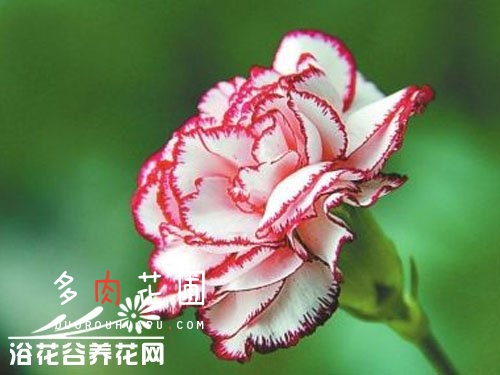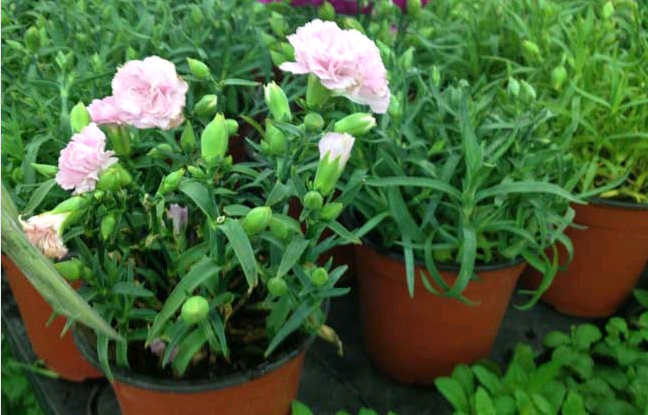How do carnations propagate by cuttings?
Carnation is mainly propagated by cutting. Because of the many sources of cutting materials, fast growth and high survival rate, it is beneficial to speed up propagation. Cuttings can be cut in all seasons except the hot summer season. In production, indoor cutting from January to March is suitable, so that it can blossom in winter and spring. Especially from January to February, the survival rate was high and the growth performance was good.
Cuttings should be selected from the mother plant with strong growth, typical characteristics of the variety and no harm to diseases and insect pests. It is better to choose the lateral branches whose basal 1-6 nodes have germinated and are 7-10 cm long. When picking buds, it is better to break them than to use scissors. It is necessary to make the base of the bud with node marks, so that it is easier to survive. The cutting medium was composed of 2 parts of garden soil and 1 part of rice chaff ash. Cut immediately after harvest to prevent wilting, or soak the buds with water before cutting. The depth of the soil is about 1 cm, and the spacing is about 2 cm.
Water immediately after planting, and cover shade, keep room temperature at 10: 13 ℃, usually start rooting in 20 days, transplant after 40-50 days, distance 5-7 cm.
The cutting propagation of carnation, also known as carnation, is an annual or perennial tufted herbaceous flower of Carnation of Carnation family. Its propagation can be carried out by sowing, cutting, striping, tissue culture and other methods, generally using cutting propagation, in winter and spring.

Generally speaking, the cutting of carnations can be carried out from December to April of the following year, especially from January to February, when the lateral buds used for cuttings grow healthily and have the best quality; at the same time, cutting during this period can control the flowering of plants in the second year New Year's Day and the Spring Festival. The survival rate of cutting in March is also higher, but the growth after that is not as good as that from January to February, which can be carried out at this time as a need for replanting. Cutting carnations, first of all, should prepare the culture soil, generally use garden soil mixed with 30% to 40% of rice chaff ash or sand, mix evenly, put into the pot or wooden box. The cuttings should be carried out in the greenhouse, and the cuttings should be selected from the mother plants with strong growth, neat flowering and thick nodes and short branches. Select short and thick lateral buds in the middle of strong branches, each 3 to 4 cm long. The "break picking method" should be adopted when picking cuttings, that is, taking the trunk of the main branch in one hand and selecting the buds in the other as the buds of the cuttings, peeling off the old leaves and buds at the same time, making the base complete and with node marks, soaking the cuttings in water or spraying water in the peeling place, so that they can absorb enough water and leave them for cutting. The depth of cuttage should be from 1 to 2 of the length of cuttings. Pour water after insertion and keep the temperature from 10 ℃ to 15 ℃. Nursery bed maintenance should be fine, water again the next day after insertion, if the leaf has a soft phenomenon, can be sprayed on the leaf surface several times, the soil is slightly moist, but not too wet. At the beginning of the insertion, it is generally necessary to shade the sun in a sunny day to avoid strong light, which can be shaded for about 2 weeks. Cuttings can take root in about 30 to 45 days, and generally can be transplanted after one month of seedling survival. If the cuttings are cut after March, the selected cuttings can be slightly longer. Due to the gradual increase in temperature, large temperature difference between day and night, and high humidity, it is necessary to set up a frame to shade the sun for about 3 weeks, and pay attention to ventilation to prevent seedlings from suffering from diseases and insect pests. Cutting Propagation of Carnation
[frequently asked questions] cutting propagation methods of carnations
Picture: Carnation
[expert answers]
1. The establishment of the mother garden of ear picking. The practice shows that the necessary conditions for the mother plant of panicle harvesting are: the relative age of the plant is young, the flowering character is good, the disease index is zero, and the panicle position should be strictly controlled above the 6th node. Therefore, the establishment of a dedicated spike-picking mother garden is very necessary and critical, and it is also an indispensable link in the process of modern carnation seedling production. It is not only the premise of forming high-quality seedlings, but also the basis of large-scale seedling raising throughout the year.
The mother plant of panicle picking mother garden must be tissue culture seedlings. The key to the cultivation and management of the mother garden is to strengthen soil disinfection, advocate crop rotation, ensure the application of adequate base fertilizer, shelter rain and shade measures, advocate drip irrigation, and do a good job in the prevention and control of diseases and insect pests.
2. Cutting technology.
Selection of ⑴ cuttings. Select pest-free, robust growth, close internodes of the plant, and have 3murmur4 pairs of unfolded leaves, 1 pair of unexpanded leaves, population cuttings with flower bud rate less than 10%.
⑵ cutting time. Generally, we should avoid the hot summer from July to August, require good cutting quality, use perlite with larger particles as the cutting parent material, good water quality, and the cutting bed is a table.
Adoption and cuttage of ⑶ cuttings. The adoption of cuttings is generally carried out at the same time as the sprouting of carnations. Cuttings should be picked according to the standard, and sprouts should be broken by hand instead of scissors to avoid virus cross-infection. There should be a slight trunk cortex at the base, but the mother branch should not be damaged, and the top leaves of cuttings should be retained for 5 pieces, and the rest of them should be removed. After finishing into bundles, soak in water for 30 minutes to make the cuttings absorb enough water. The section should be close to the internodes and treated with growth regulators in order to improve the survival rate and emergence rate. When cutting, it is appropriate to insert 1 cm of medium. Insert deeply in summer, usually 1.5-2 cm. After cutting to spray enough water, later control should not be too wet, so as not to rot the root.
Storage of ⑷ cuttings. Storing cuttings can not only provide great convenience for raising seedlings and balanced flower supply throughout the year, but also can carry out batch operation at one time and save manpower and material resources. Storage requirements: temperature 1 ℃ 2 min, and the smaller the range, the better, preferably within ±1 ℃; slightly dehydrated before storage; cuttings packed with ultra-thin plastic film.
⑸ cuttage management. The slotting machine should have intermittent spraying facilities, and the amount of spray should be controlled to make the blade just wet. If there is no spray, cover the plastic film and use the Reed curtain after 1 week, but do not block too much light to prevent overgrowth. Transplant when the root of the cuttage is 1 cm long, pay attention to less root damage.
[editor's summary]
The reproduction methods of carnations are divided into sexual reproduction and asexual reproduction, but in the process of planting, the common method is cutting propagation. The first Agricultural Classic editor introduces the cutting propagation methods of carnations to you in this article. I hope it will be helpful to you.
- Prev

Control methods of anthracnose of Gardenia jasminoides
[symptoms] the disease mainly damages the leaves of Gardenia jasminoides. From the leaf tip, leaf edge began to occur, the formation of irregular or nearly round brown spots. Sometimes the whole leaf turns brown, causing the branch to wither or the whole plant to die. Most of the diseases occurred from the lower leaves of the plant. Under wet conditions
- Next

How do carnations propagate and manage?
Carnations are generally propagated by cuttings. Cuttings are carried out in early spring. The third to fourth lateral buds in the middle of the branch were selected as cuttings, and the sprouting branches in the rhizosphere were the best. Cutting is more suitable when flower buds are formed. Cuttings should be cut immediately after cutting. On a cloudy day or in the morning. After cutting, the section at the base is stained with charcoal powder.
Related
- Fuxing push coffee new agricultural production and marketing class: lack of small-scale processing plants
- Jujube rice field leisure farm deep ploughing Yilan for five years to create a space for organic food and play
- Nongyu Farm-A trial of organic papaya for brave women with advanced technology
- Four points for attention in the prevention and control of diseases and insect pests of edible fungi
- How to add nutrient solution to Edible Fungi
- Is there any good way to control edible fungus mites?
- Open Inoculation Technology of Edible Fungi
- Is there any clever way to use fertilizer for edible fungus in winter?
- What agents are used to kill the pathogens of edible fungi in the mushroom shed?
- Rapid drying of Edible Fungi

